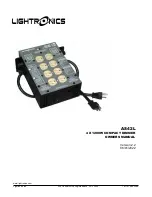
13 ENGLISH
NOTE:
Depending on the conditions of use and the
ambient temperature, the indication may differ slightly
from the actual capacity.
NOTE:
The first (far left) indicator lamp will blink when
the battery protection system works.
Tool / battery protection system
The tool is equipped with a tool/battery protection
system. This system automatically cuts off power to
the motor to extend tool and battery life. The tool will
automatically stop during operation if the tool is placed
under one of the following conditions:
►
Fig.3:
1.
Caution lamp
Caution lamp
Status
Color
On
Blinking
Green
Overload
Red
(tool) /
(battery)
Overheat
Red
Over
discharge
Overload protection
If the tool or battery is overloaded by entangled
branches or other debris, the tool automatically stops
and the caution lamp starts blinking in green.
In this situation, turn the tool off and stop the application
that caused the tool to become overloaded. Then turn
the tool on to restart.
NOTICE:
Depending on the usage conditions,
the tool is automatically turned off without any
indication if the tool is overloaded by entangled
branches or debris. In this case, switch off the
tool and remove the battery cartridge, and then
remove entangled branches or debris using tools
such as pliers. After removing the branches or
debris, install the battery cartridge and turn on
the tool again.
Overheat protection for tool or
battery
If the tool or battery cartridge is overheated, the tool
stops automatically. When the tool is overheated, the
caution lamp lights up in red. When the battery cartridge
is overheated, the caution lamp blinks in red. Let the
tool and/or battery cool down before turning the tool on
again.
Overdischarge protection
When the battery capacity becomes low, the tool stops
automatically and the caution lamp starts blinking in red.
If the tool does not operate even when the switches are
operated, remove the battery cartridge from the tool and
charge it.
Angle setting of the handle
CAUTION:
Always make sure that the handle
is locked in the desired position before operation.
CAUTION:
Do not pull down the lever to
unlock the handle while pulling the switch trigger.
Do not pull the switch trigger while pulling down
the lever and turning the handle.
Failure to do so
may cause a malfunction of the tool.
You can set the angle of the handle to 0°, 45°, or 90°
to the left or right. To change the angle of the handle,
turn the handle while pulling down the lever, and then
release the lever.
►
Fig.4:
1.
Lever
Power switch action
WARNING:
For your safety, this tool is
equipped with lock-off lever which prevents the tool
from unintended starting. NEVER use the tool if it
runs when you simply press the switch lever and
pull the switch trigger without pressing the lock-
off lever. Return the tool to our authorized service
center for proper repairs BEFORE further usage.
WARNING:
NEVER tape down or defeat pur-
pose and function of lock-off lever.
WARNING:
Before installing the battery car-
tridge on the tool, always check to see that the
switch trigger and switch lever actuate properly and
return to the "OFF" position when released.
Operating
a tool with a switch that does not actuate properly can
lead to loss of control and serious personal injury.
CAUTION:
Never put your finger on the
switch when carrying.
The tool may start uninten
-
tionally and cause injury.
NOTICE:
Do not pull the switch trigger hard with-
out pressing the lock-off lever. This can cause
switch breakage.
Press the main power button to turn on the tool. To turn
off the tool, press and hold the main power button until
the speed indicators go off.
►
Fig.5:
1.
Main power button
NOTE:
The caution lamp brinks if the switch trigger
is pulled under unoperatable conditions. The caution
lamp blinks if you turn on the main power switch while
holding down the lock-off lever and the switch trigger.
NOTE:
This tool employs the auto power-off function.
To avoid unintentional start up, the main power switch
will automatically shut down when the switch trigger
is not pulled for a certain period after the main power
switch is turned on.
To prevent the switch trigger from being accidentally
pulled, a lock-off lever is provided. To start the tool,
depress the lock-off lever, and then press the switch
lever and pull the switch trigger. Release the switch
trigger to stop.
►
Fig.6:
1.
Switch lever
2.
Lock-off lever
3.
Switch
trigger
Summary of Contents for UH004G
Page 2: ...2 3 1 1 Fig 1 1 2 Fig 2 1 Fig 3 1 Fig 4 1 Fig 5 1 2 3 Fig 6 2 1 Fig 7 2 ...
Page 3: ...2 1 Fig 8 1 Fig 9 2 1 Fig 10 1 2 Fig 11 1 2 3 4 Fig 12 1 2 Fig 13 1 1 Fig 14 1 Fig 15 3 ...
Page 4: ...1 2 3 4 Fig 16 1 2 Fig 17 1 2 3 Fig 18 1 2 Fig 19 1 2 Fig 20 1 Fig 21 1 Fig 22 4 ...
Page 5: ...1 Fig 23 1 Fig 24 1 2 Fig 25 Fig 26 Fig 27 Fig 28 Fig 29 Fig 30 5 ...
Page 6: ...Fig 31 Fig 32 Fig 33 1 Fig 34 Fig 35 1 2 Fig 36 1 2 Fig 37 1 Fig 38 6 ...
Page 7: ...1 Fig 39 2 1 Fig 40 7 ...














































